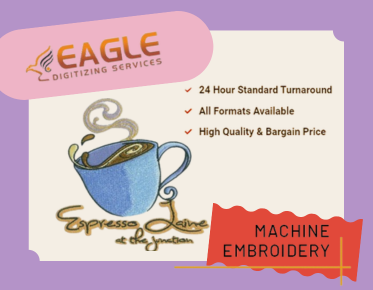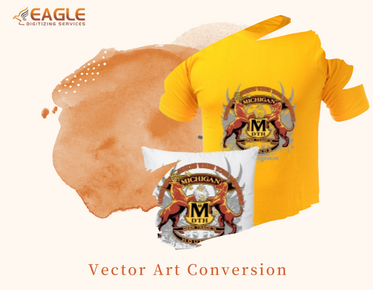How Does an Embroidery Machine Create Stitching from Eagle Digitizing?
Embroidery, once characterized by meticulous manual labor, has undergone a revolutionary transformation thanks to modern technology, particularly the advent of embroidery machines. These sophisticated devices seamlessly integrate precision engineering with computerized controls to efficiently and accurately produce intricate designs on fabric. Curious about the intricate workings behind these machines? For the top-notch digitizing service, don't hesitate to get in touch with us.Let's delve into the fascinating process step by step:
1. Design Input and Digitization: Before the embroidery process commences, a digital design is indispensable. These designs can originate from various sources:
○ Pre-made Designs: Ready-to-use designs available for purchase or download.
○ Custom Designs: Crafted using specialized embroidery software, allowing users to either draw or import images to create entirely unique patterns.
○ Digitization: This pivotal phase involves converting artwork into a format comprehensible to the embroidery machine. It entails assigning stitch types, densities, and sequential instructions to each segment of the design. This meticulous process ensures that the machine interprets and executes the design accurately during embroidery.
2. Machine Setup
Once the design is finalized, the next critical phase is the machine setup. This step involves several precise actions to ensure the embroidery process runs smoothly and yields high-quality results.
1. Loading the Design: The digital design is transferred to the embroidery machine. This is typically done via USB, memory card, or direct connection to a computer. Advanced embroidery machines come equipped with touchscreens or interfaces that allow users to preview the design and make final adjustments before stitching begins. This ensures that any last-minute changes can be easily implemented without restarting the entire process.
2. Hooping the Fabric: Properly hooping the fabric is crucial for maintaining tension and stability throughout the embroidery process. The fabric is placed between two rings – the outer and inner hoops – and tightened to remain taut. This tension is essential to prevent puckering, misalignment, or distortion of the design. Modern hoops come in various sizes and shapes to accommodate different fabric types and project requirements.
3. Fabric Compatibility and Adjustment: Contemporary embroidery machines are designed to handle a wide array of fabrics, from delicate silks to heavy denim. Each fabric type requires specific settings to achieve optimal stitching quality. The machine automatically adjusts parameters such as thread tension, needle type, and stitch density based on the fabric being used. For instance, lighter fabrics might require lower thread tension and finer needles, while heavier fabrics might need higher tension and sturdier needles to ensure the stitches are secure and the design remains intact.
4. Threading the Machine: The embroidery thread is carefully threaded through the machine's various guides, tension disks, and needle. This process must be done with precision to avoid thread breaks or uneven stitching. Some modern machines feature automatic threading mechanisms that simplify this task, ensuring the thread is correctly positioned for flawless operation.
5. Positioning the Design: With the fabric hooped and the machine threaded, the next step is to position the design accurately on the fabric. This involves aligning the hoop with the machine's embroidery area and ensuring that the design will be centered or placed correctly as intended. Many machines offer laser guides or built-in cameras to assist with precise positioning, allowing for perfect alignment every time.
By meticulously preparing the machine and fabric, these steps lay the groundwork for a successful embroidery project. The attention to detail during the machine setup phase ensures that the embroidery process will proceed smoothly, producing beautifully crafted designs with professional-quality results.
3. Thread Selection and Threading
Embroidery machines are designed to handle multiple threads simultaneously, enabling the creation of colorful and intricate designs. This capability is one of the defining features that distinguishes modern embroidery machines from their manual counterparts, allowing for complex patterns and vibrant visuals with ease. Here's a closer look at how this multi-thread functionality works and the meticulous process involved:
1. Thread Selection and Color Coordination: Before the embroidery begins, the appropriate threads must be selected. These threads come in a vast array of colors and types, such as cotton, polyester, rayon, or metallic, each offering different aesthetic and functional properties. Designers or machine operators choose threads that best suit the design's requirements and the fabric being used.
2. Thread Spooling and Placement: Each thread spool is placed on its designated spindle on the machine. Embroidery machines can have multiple spindles, allowing them to hold several thread colors simultaneously. High-end commercial machines might hold dozens of different threads, while home models typically manage between six to ten spools.
3. Threading the Machine: The threads are then carefully threaded through designated paths within the machine. Each thread follows a specific route through various guides, tension discs, and thread paths, which ensure they are properly tensioned and positioned for stitching. This intricate threading process is crucial for maintaining smooth operation and preventing tangling or thread breaks during embroidery.
4. Automatic Thread Management: Modern embroidery machines often come equipped with automatic thread management systems. These systems can cut threads, switch between different colors, and re-thread needles as needed during the embroidery process. This automation significantly reduces the manual intervention required and enhances the efficiency and accuracy of the stitching.
5. Color Changes and Thread Control: As the machine stitches the design, it follows the digitized instructions that dictate which colors to use and when to switch threads. The machine's software controls the thread changes, ensuring each part of the design is embroidered with the correct color. This precise control allows for intricate detailing and seamless transitions between different sections of the design.
6. Preventing Tangling and Ensuring Smooth Operation: To prevent tangling, the threads must be kept under consistent tension and properly separated. The machine's tension discs and guides play a vital role in this, ensuring that each thread feeds smoothly into the needle without interference from other threads. Additionally, regular maintenance and cleaning of the machine help prevent lint buildup and other issues that could cause thread tangling or breakage.
By managing multiple threads simultaneously, embroidery machines can produce complex, multicolored designs with remarkable precision and efficiency. This multi-thread functionality is a testament to the advanced engineering and technology that have transformed embroidery from a labor-intensive craft into a streamlined and versatile art form.
4. Stitching Process
Here’s where the magic happens:
● Needle and Bobbin Coordination: The machine coordinates the movement of the needle (or needles) and bobbin thread to create stitches. The needle penetrates the fabric, pulling the top thread through from above, while the bobbin thread locks it in place from below.
● Stitch Types: Various stitch types are employed, such as satin stitches for smooth surfaces, fill stitches for larger areas, and running stitches for outlines. These stitches are sequenced according to the design’s instructions, layering threads to create depth and detail.
5. Computerized Precision
● Control Systems: Modern embroidery machines are equipped with sophisticated computerized controls. These systems manage stitch length, tension, and speed, ensuring consistent quality across the entire design.
● Automatic Features: Some machines include automatic features like thread cutting, color changes, and pattern rotation. These streamline production and reduce manual intervention.
6. Finishing Touches
Once the design is complete, the fabric is removed from the hoop. Any excess stabilizer used to reinforce the fabric during stitching is trimmed away. The finished embroidered piece is now ready for use or further embellishment.
7. Maintenance and Care
Regular maintenance is crucial to keep an embroidery machine running smoothly and efficiently. Just like any other complex piece of equipment, an embroidery machine requires consistent care to ensure it operates at its best. Proper maintenance not only extends the machine's lifespan but also ensures consistent stitching quality, preventing interruptions and costly repairs.
Regular maintenance is crucial for keeping your embroidery machine running smoothly and ensuring consistent stitching quality. By performing routine cleaning, oiling, and tension checks, you can extend the machine’s lifespan and prevent costly repairs. Whether you use your embroidery machine for personal projects or professional work, proper care and maintenance will help you achieve the best possible results and enjoy the creative process without interruptions.
8. Artistry and Creativity
While the machine handles the technical aspects, the artistry lies in the initial design and the operator’s skill in selecting threads, adjusting settings, and overseeing the process. This blend of technology and creativity allows for endless possibilities in embroidery design.
Conclusion
Embroidery machines have transformed the world of textile arts, making intricate and detailed embroidery accessible to a wider audience than ever before. By understanding the mechanics behind these machines, one can gain a greater appreciation for the craftsmanship involved in creating embroidered masterpieces. From design conception to the final stitched product, the fusion of technology and artistry in embroidery machines has elevated the craft, allowing for the production of stunning works of art on fabric. Whether you are a novice or an experienced embroiderer, these machines offer endless possibilities for creativity and innovation in the textile arts.
Exploring the workings of an embroidery machine unveils a world where technology and creativity intersect to produce stunning works of art on fabric. Eagle Digitizing offers embroidery digitizing services. By understanding the technological innovations and creative possibilities these machines offer, you can enhance your appreciation of the craft and expand your own artistic horizons. Whether you are a novice or an experienced embroiderer, embracing the capabilities of modern embroidery machines opens up endless opportunities for creating beautiful and intricate textile art.



